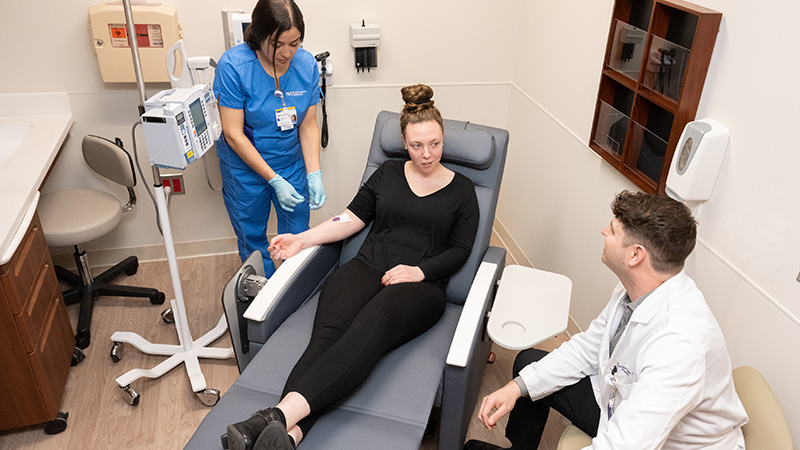Back-to-School Anxiety
Facing First-Day Fears
Updated August 2023
Apprehension the night before the first day of school is normal. New experiences — away from parents, siblings and other loved ones — can be frightening for children, even if it’s not their first time going to school. Sources of school-related anxiety can be anything from separation anxiety, to the fear of the unknown, to a challenging teacher or assignment, to bullying.
“You know your child’s behavior and mood best,” says Allison Kranich, MS, LCPC, CAADC, a therapist at Northwestern Medicine. “Feelings of nervousness and worries are typical. Anxiety, however, includes symptoms — for example, worries, difficulty controlling worries, difficulty concentrating — that are persistent and can impact your child’s level of functioning at home and school. Each child will present signs differently.”
Here are some possible signs of anxiety to look out for as your child heads back to school.
Back-to-school anxiety is typical. Each child will present signs differently.— Allison Kranich, MS, LCPC, CAADC
Complaining of physical ailments, like an upset stomach, headache or something else. “For many children, anxiety can manifest as physical symptoms,” explains Kranich.
Changes in sleep habits. “Your child may complain of nightmares or difficulty sleeping, refuse to sleep alone, or need frequent reassurance that everything is OK before bed,” says Kranich.
Changes in mood or appetite. This can include clingy behavior, pleading, tantrums or arguments. “Once school starts, maybe you’ll start getting more calls from the school that your child is misbehaving, acting out, becoming withdrawn or not learning things,” adds Kranich. “This may be a sign of anxiety.”
Saying phrases indicating they don’t want to return to school, such as:
- “I don’t like school or my classroom.”
- “I wish summer would last forever.”
- “I don’t like my classmates.”
How to Help Your Student Cope With Anxiety
Open a dialogue with your child. Children respond very well to directness, says Kranich. She suggests opening a dialogue with your child by saying something like, “I’ve noticed you seem quieter lately. Is something bothering you?” Direct, open-ended questions work best. It can be helpful to label your child’s behaviors to help them to identify their feelings. For example, you can say, “You are getting more tummy aches lately. Let’s work together to figure out what feelings go along with the tummy aches.”
Additionally, ask your child open-ended questions based on your observations to help identify the source of their anxiety. If your child identifies feeling worried, you can follow up with other questions such as, “What is making you feel worried?” Aim to ask questions that start with “what” rather than “why,” as these are easier for children and teens to answer.
Not all children will act out because of anxiety. Some children may internalize things, become more withdrawn and isolate themselves. Look for signs and symptoms that are atypical for your child.
Tell the teacher. “Most teachers are experts at handling anxiety in the first few days of school because of how common it is,” says Kranich. “They also can monitor your child’s relationships with classmates to rule out bullying as the source of anxiety. If problems persist, parents can also check in with the school social worker.”
In-person socialization. Having face-to-face interactions is important for kids’ social and emotional growth. Kranich advises having friends come over. “It is always better to talk to someone while seeing their face than not at all,” says Kranich. “If children don’t have that interaction, they will have a difficult time going back to school.”
Make your child go to school. Be supportive, yet firm. “Parents want to protect their children, but avoidance is a sign of anxiety and most times ineffective in treating anxiety,” Kranich says. “The first step to helping your child is getting them in the building.” Reward your child with verbal praise every time they go to school and manage their emotions throughout the day. And don’t give in to tantrums; this teaches your child that acting out will get them what they want.
Work with your child and give them strategies for coping. Listen carefully to your child’s concerns so that you can involve them in the solution to the problem. You’ll find that keeping an open dialogue and asking open-ended questions can help improve your child’s symptoms and give you more information about the situation.
“You can also give your child tools, like breathing exercises, to use when they’re at school,” says Kranich. “Deep breaths from the belly are underrated and not used enough; they tell your body that everything is OK.”
When to Seek Help
Most of the time, school-related anxiety ends quickly. If your child continues to refuse to go to school or has more tantrums, then they may be dealing with a more persistent form of anxiety or other mental health issues. Sometimes, but not always, these can stem from a reaction to a recent event, like the illness or death of a family member or friend, divorce or remarriage, or moving somewhere new. It’s also important to note that children with a family history of anxiety may be more likely to have anxiety in general.
Contact your child’s physician or a behavioral health professional if the behavior lasts for more than a few days or if the symptoms seem severe.
“Most of the time, school-related worries end quickly,” says Kranich.







